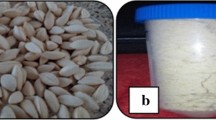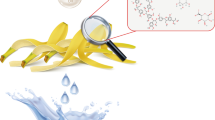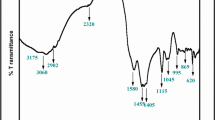Abstract
Purpose
Banana peel was used as a low-cost adsorbent for the removal of Cu and Pb ions from aqueous solution in a binary system.
Methods
The interactive effects of the operating parameters such as initial concentration, pH, adsorbent dosage and particle size were studied in a batch mode using central composite design. The characterizations of banana peels were done using point of zero charge (pHpzc), Fourier infrared transform (FTIR), scanning electron microscopy (SEM) and elemental composition (EDS).
Result
The point of zero charge of banana peels was determined to be 4.83. The FTIR, SEM and EDS showed the functional groups, surface morphology and elemental composition respectively before and after the adsorption process. The analysis of variance (ANOVA) showed a good fit of coefficient of determination (R2) for Cu and Pb being 0.998 and 0.988 respectively. The percentage removal of Cu and Pb increased with increasing adsorbent dosage, however, the bio-sorption capacity of Pb was greater than Cu. The optimized variable conditions for the bio-sorption of Cu and Pb using banana peel gave 99.79% and 88.94% removal for Pb and Cu respectively with initial concentration of 100 mg/L, pH 5, adsorbent dosage of 1 g and particle size of 75 μm. The above condition gave desirability of 0.959, which denotes that the optimum conditions are acceptable.
Conclusion
The regression model and the agreement between the experimental and predicted values confirmed the validity of second-order polynomial equation for the bio-sorption of Cu and Pb using banana peels.







Similar content being viewed by others
References
Matsumoto S, Shimada H, Sasaoka TJNR. The key factor of acid mine drainage (AMD) in the history of the contribution of mining industry to the prosperity of the United States and South Africa: a review. Nat Resour. 2016;7:445–60.
Cherry DS, Currie RJ, Soucek DJ, Latimer HA, Trent GC. An integrative assessment of a watershed impacted by abandoned mined land discharges. Environ Pollut. 2001;111:377–88.
Neculita CM, Zagury GJ, Bussière B. Passive treatment of acid mine drainage in bioreactors using sulfate-reducing bacteria. J Environ Qual. 2007;36:1–16.
Strosnider W, López FL, Nairn R. Acid mine drainage at Cerro Rico de Potosí I: unabated high-strength discharges reflect a five century legacy of mining. Environ Earth Sci. 2011;64:899–910.
Strosnider WH, López FL, Nairn R. Acid mine drainage at Cerro Rico de Potosí II: severe degradation of the upper Rio Pilcomayo watershed. Environ Earth Sci. 2011;64:911–23.
Wei TT, Yu Y, Hu ZQ, Cao YB, Gao Y, Yang YQ, et al. Research progress of acid mine drainage treatment technology in China. Trans Tech Publ. 2013;409:214–20.
Antivachis DN, Chatzitheodoridis E, Skarpelis N, Komnitas K. Secondary sulphate minerals in a Cyprus-type ore deposit, Apliki, Cyprus: mineralogy and its implications regarding the chemistry of pit lake waters. Mine Water Environ. 2017;36:226–38.
Balci N, Demirel C. Prediction of acid mine drainage (AMD) and metal release sources at the Küre copper mine site, Kastamonu. NW Turkey Mine Water Environ. 2018;37:56–74.
Araujo CST, Carvalho DC, Rezende HC, Almeida ILS, Coelho LM, Coelho NMM, Marques TL, Alves VN. Bioremediation of waters contaminated with heavy metals using Moringa oleifera seeds as biosorbent 2013; https://doi.org/10.5772/56157.
Guechi EK, Hamdaoui O. Evaluation of potato peel as a novel adsorbent for the removal of cu (II) from aqueous solutions: equilibrium, kinetic, and thermodynamic studies. Desalin Water Treat. 2016;57:10677–88.
Kumar PS, Ramalingam S, Kirupha SD, Murugesan A, Vidhyadevi T, Sivanesan S. Adsorption behavior of nickel (II) onto cashew nut shell: equilibrium, thermodynamics, kinetics, mechanism and process design. J Chem Eng. 2011;167:122–31.
Lakshmipathy R, Sarada NC. A fixed bed column study for the removal of Pb2+ ions by watermelon rind. Environ Sci: Water Res Technol. 2015;1:244–50.
Lathan N, Edward S, Thomas C, Agwaramgbo L. Comparative study of Lead removal by extracts of spinach, coffee, and tea. J Environ Prot. 2013;04:250–7.
Mahmoud MA. Kinetics studies of uranium sorption by powdered corn cob in batch and fixed bed system. J Adv Res. 2016;7:79–87.
Witek-Krowiak A, Chojnacka K, Podstawczyk D, Dawiec A, Pokomeda K. Application of response surface methodology and artificial neural network methods in modelling and optimization of biosorption process. Bioresour Technol. 2014;160:150–60.
Kamsonlian S, Balomaju C, Chand S. Characterization of banana and orange peels: biosorption mechanism. Int J Sci Technol Manag. 2011;2:1–7.
Li XT, Yanru X, Zhexian L, Yinghui L, Fang L. Study on the preparation of orange peel cellulose adsorbents and biosorption of Cd2+ from aqueous solution. Sep Purif Technol. 2007;55:69–75.
Arunakumara K, Walpola BC, Yoon MH. Banana Peel: a green solution for metal removal from contaminated waters. Korean J Environ Agric. 2013;32:108–16.
Kaewsarn P, Saikaew W, Wongcharee S. Dried biosorbent derived from banana peel: a potential biosorbent for removal of cadmium ions from aqueous solution. Thailand Chem Eng Appl Chem. 2008;2:552–8.
Amin MT, Alazba AA, Shafiq M. Removal of copper and Lead using Banana biochar in batch adsorption systems: isotherms and kinetic studies. Arab J Sci Eng. 2017;43:5711–22.
Mondal NK. Natural Banana (Musa acuminate) Peel: an unconventional adsorbent for removal of fluoride from aqueous solution through batch study. Water Conserv Sci Eng. 2016;1:223–32.
Hossain MA, Ngo H, Hao Guo WS, Nguyen TV. Removal of copper from water by adsorption onto banana peel as bioadsorbent. Int J Geomate. 2012;2:227–34.
Oyewo OA, Onyango MS, Wolkersdorfer C. Application of banana peels nanosorbent for the removal of radioactive minerals from real mine water. J Environ Radioact. 2016;164:369–76.
Montgomery DC. Design and analysis of experiments. 6th ed. Hoboken, N.J: John Wiley & Sons; 2005.
Nair AT, Makwana AR, Ahammed MM. The use of response surface methodology for modelling and analysis of water and wastewater treatment processes: a review. Water Sci Techn. 2014;69(3):464–78.
Pathak PD, Mandavgane SA, Kulkarni BD. Fruit peel waste: characterization and its potential uses. Curr Sci. 2017;113:444–54.
Madala S, Mudumala VNR, Vudagandla S, Abburi K. Modified leaf biomass for Pb(II) removal from aqueous solution: application of response surface methodology. Ecol Eng. 2015;83:218–26.
Amin M, Alazba A, Shafiq M. Batch and fixed-bed column studies for the biosorption of cu (II) and Pb (II) by raw and treated date palm leaves and orange peel. Global Nest J. 2017;19:464–78.
Feng NC, Guo XY. Characterization of adsorptive capacity and mechanisms on adsorption of copper, lead and zinc by modified orange peel. Trans Nonferrous Met Soc China. 2012;22:1224–31.
Hossain MA, Ngo H, Guo WS, Nghiem LD, Hai FI, Vigneswaran S, et al. Competitive adsorption of metals on cabbage waste from multi-metal solutions. Bioresour Technol. 2014;160:79–88.
da Silva Correia IK, Santos PF, Santana CS, Neris JB, Luzardo FHM, Velasco FG. Application of coconut shell, banana peel, spent coffee grounds, eucalyptus bark, piassava (Attalea funifera) and water hyacinth (Eichornia crassipes) in the adsorption of Pb2+ and Ni2+ ions in water. J Environ Chem Eng. 2018;6:2319–34.
Anwar J, Shafique U, Zaman Waheed UZ, Saman M, Dar A, Anwar S. Removal of Pb(II) and cd(II) from water by adsorption on peels of banana. Bioresour Technol. 2010;101:1752–5.
Iqbal M, Khera RA. Adsorption of copper and lead in single and binary metal system onto Fumaria indica biomass. Chem Int. 2015;1:157b–63b.
Ashraf MA, Wajid A, Mahmood K, Maah MJ, Yusoff I. Removal of heavy metals from aqueous solution by using mango biomass. Afr J Biotechnol. 2011;10:2163–77.
Kumar K, Patavardhan SS, Lobo S, Gonsalves R. Equilibrium study of dried orange peel for its efficiency in removal of cupric ions from water. Int J Phytoremediat. 2018;20:593–8.
Acknowledgements
The authors wish to appreciate National Research Foundation (NRF) of South Africa for their financial support, Durban University of Technology and Mangosuthu University of Technology for their support in using certain equipment for the analytical work conducted for this study.
Funding
The authors appreciated the financial support of National Research Foundation (Grant Nu: 105235).
Author information
Authors and Affiliations
Corresponding author
Ethics declarations
Conflict of interest
The authors declare that they have o conflict of interest.
Additional information
Publisher’s note
Springer Nature remains neutral with regard to jurisdictional claims in published maps and institutional affiliations.
Supplementary Information
ESM 1
(DOCX 4009 kb)
Rights and permissions
About this article
Cite this article
Afolabi, F.O., Musonge, P. & Bakare, B.F. Bio-sorption of a bi-solute system of copper and lead ions onto banana peels: characterization and optimization. J Environ Health Sci Engineer 19, 613–624 (2021). https://doi.org/10.1007/s40201-021-00632-x
Received:
Accepted:
Published:
Issue Date:
DOI: https://doi.org/10.1007/s40201-021-00632-x




